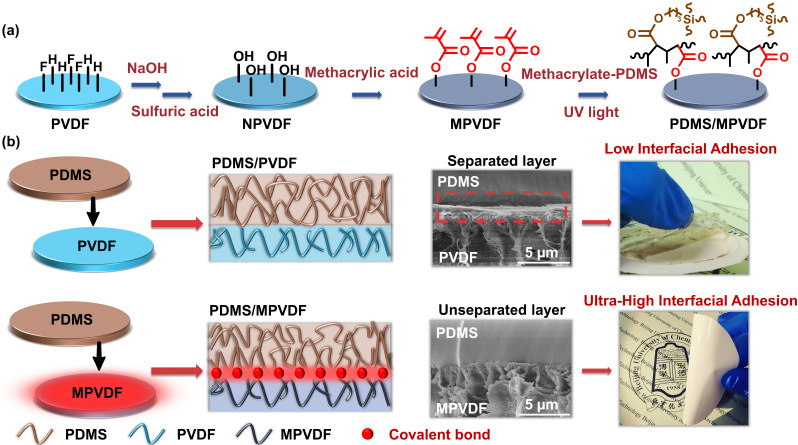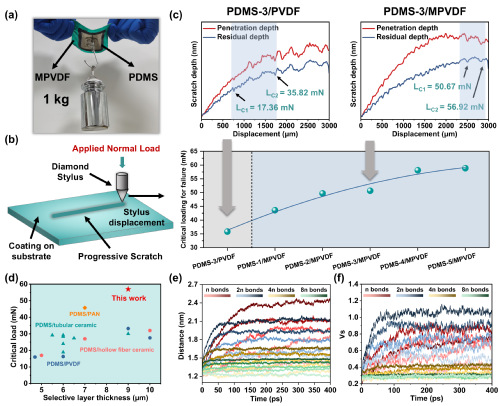Phenol, as an important platform compound, is a raw material for the synthesis of many pharmaceuticals, such as salicylic acid, aspirin and sulfonamides; therefore, the development of efficient phenol separation technology is of great significance. Membrane separation technology has received widespread attention as a common key technology for high efficiency and energy saving; among them, thin-film composite (TFC) membranes, which are functional composite membrane structures based on a separating selective layer and a supportive substrate, play an important role in the fields of bioenergy, biomedicine, and wastewater treatment. However, the physical interaction between the selective layer and the supporting substrate in the traditional TFC structure is often characterized by poor interfacial adhesion and easy dissolution resulting in stripping, which results in loss of membrane performance and shortened lifetime; especially when dealing with extreme conditions such as high temperatures, high solvent concentrations, or high solids, the structural stability of the interlayer structure is still a challenge. The research team has prepared super-interfacially stabilized PDMS/PAN composite membranes by designing the interlayer molecular structure (Materials Horizons 2024, 11, 4681-4688), which has achieved certain results; in comparison, PVDF is more suitable for PDMS TFC membranes due to its excellent hydrophobicity, but its inherent chemical inertness is a challenge for directional chemical modification. However, its inherent chemical inertness is a challenge for targeted chemical modification.
Recently, Prof. Peiyong Qin's team at Beijing University of Chemical Technology, together with Prof. Pengfei Cao, published the latest paper “Interlayer Assembly of Thin-Film Composite Membranes with Ultra-Interfacial Membranes” in Advanced Functional Materials, one of the top journals in the field of materials. Interlayer Assembly of Thin-Film Composite Membranes with Ultra-Interfacial Adhesion" (DOI: 10.1002/adfm.202420130). The authors rationally designed the interlayer chemical bonding structure and proposed a photo-triggered PDMS/PVDF TFC interlayer assembly strategy for in situ construction of permeation vaporized membranes with ultra-interfacial adhesion and efficient separation performance. The interfacial adhesion of the structure was 59% higher than that of the traditional interlayer physically interacting membranes, which was the highest level of the same type of TFC membranes; for example, the separation of 1000 ppm phenol at 60 °C showed a separation factor of 8.1 and a permeation flux of 2434 g m-2 h-1 superior to that of the same type of PDMS TFC membranes.

Fig. 1 Design of super-interfacial adhesion TFC membrane structure

Fig. 2 Characterization of super-interfacial adhesion TFC membrane materials

Fig. 3 Evaluation of interface adhesion performance and stress-strain simulation

Fig. 4 Evaluation of separation performance

Figure 5 Separation stability evaluation and electrostatic potential calculation
Prof. Peiyong Qin and Associate Prof. Zhihao Si from School of Life Science and Technology, Beijing University of Chemical Technology, Prof. Pengfei Cao from School of Materials Science and Engineering are the corresponding authors, Chao Sang and Siyuan Zhang are the co-first authors, and Beijing University of Chemical Technology is the first unit of completion of the paper.
Author Bio:
Prof. Peiyong Qin, Ph.D. supervisor, Changjiang Scholar Distinguished Professor, Beijing Science and Technology Rising Star, is currently the President of Paris Curie Ingenieur of Beijing University of Chemical Technology, and has long been committed to the basic research and application development of bioenergy and membrane separation. He has published more than 100 SCI papers in high level journals such as Angew. Chem. Int. Ed., Adv. Funct. Mater., Appl. Catal. B: Environ., Small, AIChE J., etc., and authorized more than 10 invention patents. He has presided over the National Key Research and Development Program and the National Natural Science Foundation of China, etc.; he has won the Second Prize of National Technological Invention, the Second Prize of National Teaching Achievement Award, the Hou Debang Prize for Chemical Science and Technology Innovation, and the Second Prize of Science and Technology Progress of Sinopec Federation.
Mr. Si Zhihao, Associate Professor, Master Supervisor, now works in the College of Life Science and Technology, Beijing University of Chemical Technology, and is currently a member of the editorial boards of Separation and Purification Technology (Top International Journal of Separation and Purification), Polymer Science & Technology, and National Science Open. He is currently a member of the editorial board of Separation and Purification Technology (Top International Journal of Separation and Purification), Polymer Science & Technology and National Science Open. He has been engaged in the development and application of membranes for biofuel/bio-based chemical separation for a long time, and has been the chair of the National Natural Science Foundation of China (NSFC) Youth Fund and the China Postdoctoral Science Foundation, etc. He has published in the journals of Angew. Chem. Int. Ed, Adv. Funct. Mater. Horiz., Green Chem., ACS Appl. Mater. Interfaces, J. Membr. Sci. and other journals, published 61 papers; authorized 6 Chinese invention patents; participated in the publication of 3 chapters of English monographs. He has been selected as one of the young talents of Beijing Municipal Association for Science and Technology, and as one of the young scholars of Beijing University of Chemical Technology, and has been awarded the Outstanding Youth Achievement Award of Beijing Membrane Society, and the Outstanding Postdoctoral Fellowship of Beijing University of Chemical Technology.
